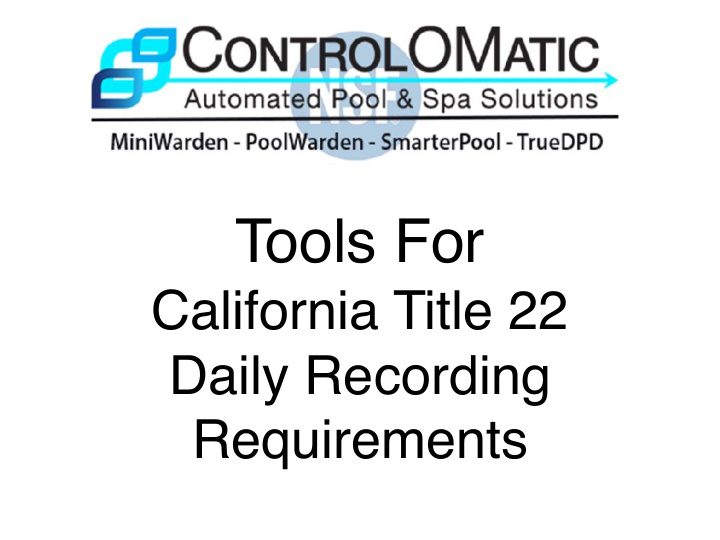



Tools For California Title 22 Daily Recording Requirements
The Process In December 2015 we started speaking to and working with several health agencies across the state to get input on how our systems can help pool owners, operators and service providers comply with Title 22 since the law has provision for an automated control system to be employed if it is approved by the local enforcing agency. We started out knowing the requirements would vary by county. Taking input from LA, Orange, San Diego and Ventura Counties, we came up with what we considered a comprehensive list of Items features that would satisfy all agencies.
The Process - Cont. Even though our systems were already of capable of capturing Free Chlorine, pH and Temperature, we still knew it would be necessary to find out what Health Departments had to say. Thanks to input from various supervisors and inspectors, we were able to fine tune the PoolWarden to offer features that came up in our discussions. The various requirements are hardware and software and can be added or activated as needed.
What We Learned LA County wanted Free Chlorine, pH and Temperature readings to be captured daily and recorded in log book during manual visits. Orange County wanted the values to be displayed on screen without having to touch the controller. San Diego County wanted the daily reading to be printed and attached to the pool log. Ventura County wanted remote monitoring and notifications.
What We Did Hardware: Serial Printer was added as an option Software: The ability to turn on auto scrolling of daily readings for Free Chlorine, pH & Temperature. Since data recording is adjustable at 15, 30 & 60 minutes, The daily noon reading is displayed along with date, time and day of week. This can also be accessed from the menu along with all the other data. 8100 lines of data can be stored in the controller and an indefinite amount can be stored online when internet communication is added.
Advantages Automation does not take vacations, need weekends and holidays off and has no reason to fudge numbers because it doesn’t forgot to take readings or go home early. Automation conserves resources. Reduces greenhouse gasses and traffic by keeping technicians from driving around to perform manual tests every day. Helps prevent dangerous water quality and excessive chemical spills from damaged chemical pumps and feed lines by monitoring 24/7/365 and notifying up to 4 people at pre-determined levels so corrective action can be taken before conditions get to critical levels.
Data Integrity The data in the controller & server cannot be manipulated. Someone would have to write down wrong information which they can do with manual readings.
Safeguards We have taken extra steps to minimize errors. Free chlorine analyzer has a diagnostic screen. The analyzer will also perform a second test if the Free Chlorine level reads more then +/- 10% of previous reading. This just like when performing a manual test and test appears to be off, a second one is done.
Safeguards 2 Status of calibration can be determined in calibration screen. Calibration is usually not needed more than monthly and only takes about 5 minutes. Alarm conditions are easily identifiable. Text & email alerts can be received in an alarm condition for proactive service if connected to internet.
Images
OC Department of Health Here is an example of how this department is allowing our equipment to be used.
Summary Our automated systems like many other processes can be more reliable and efficient than manually performing testing with minimal supervision by trained service personnel. We offer full training and phone support to our users as well as an operation, training & information website. http://poolwardentraining.com For more information contact ControlOMatic 530.205.4520 ext. 105 or support@controlomatic.com
Recommend
More recommend